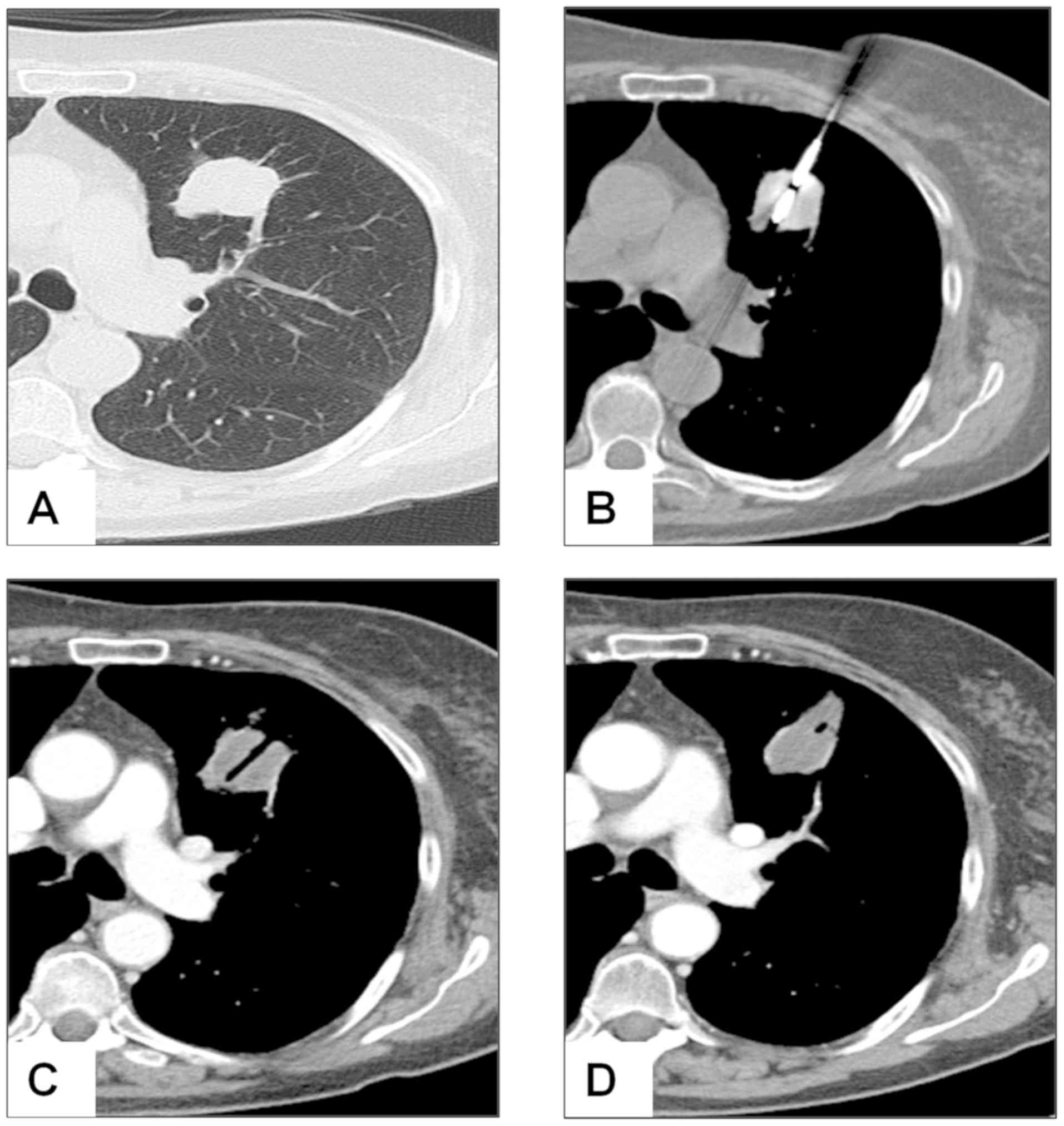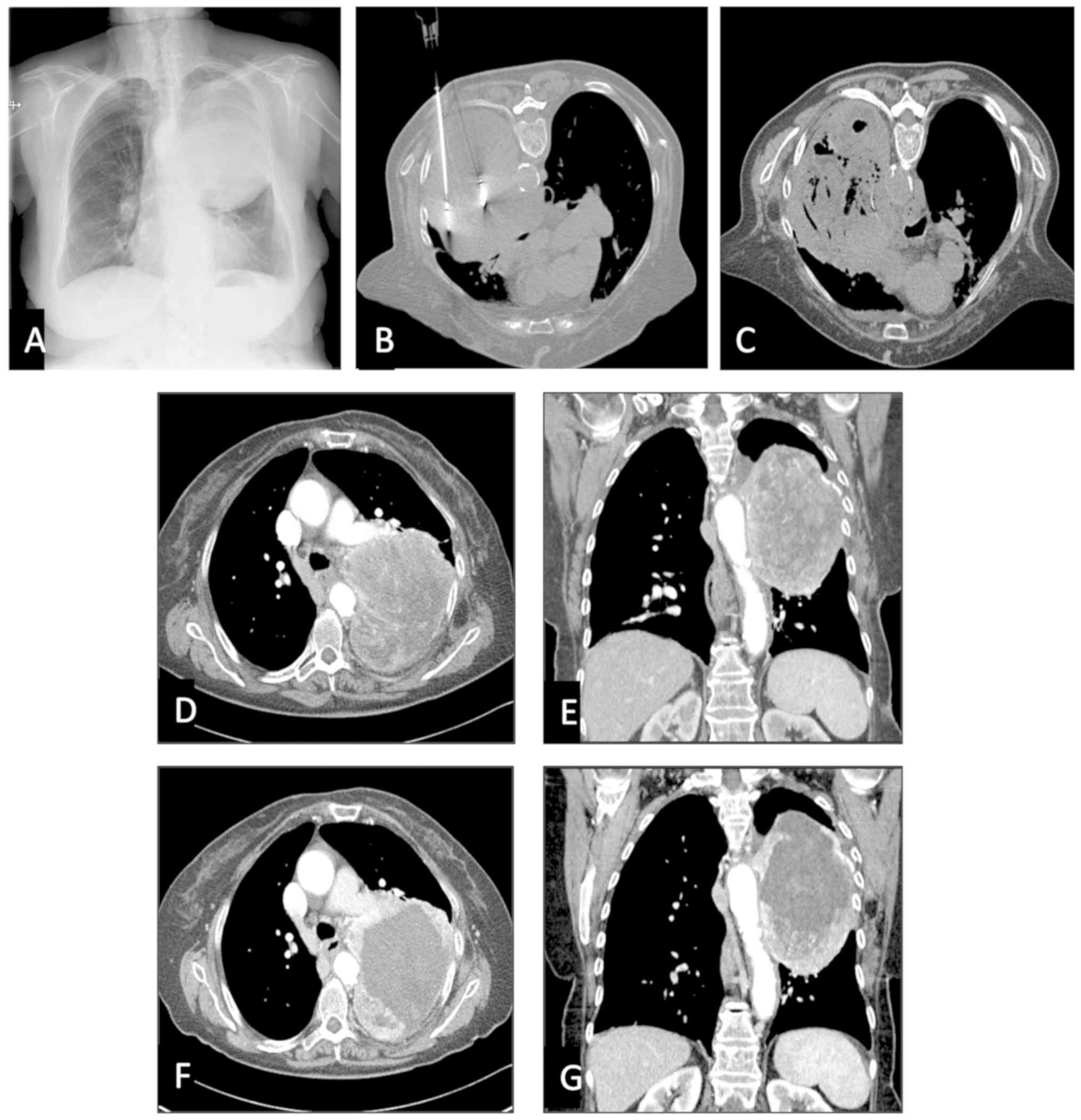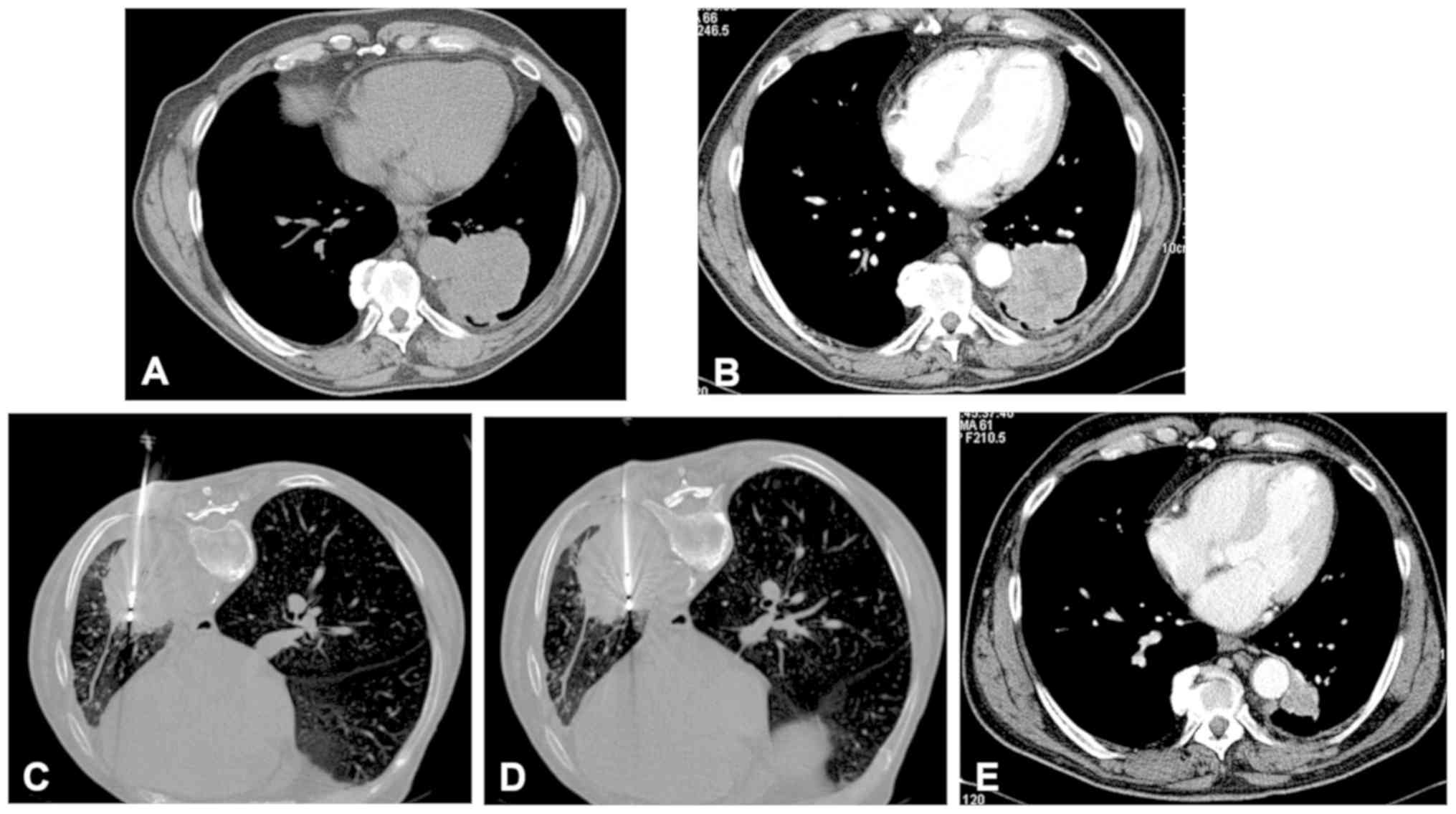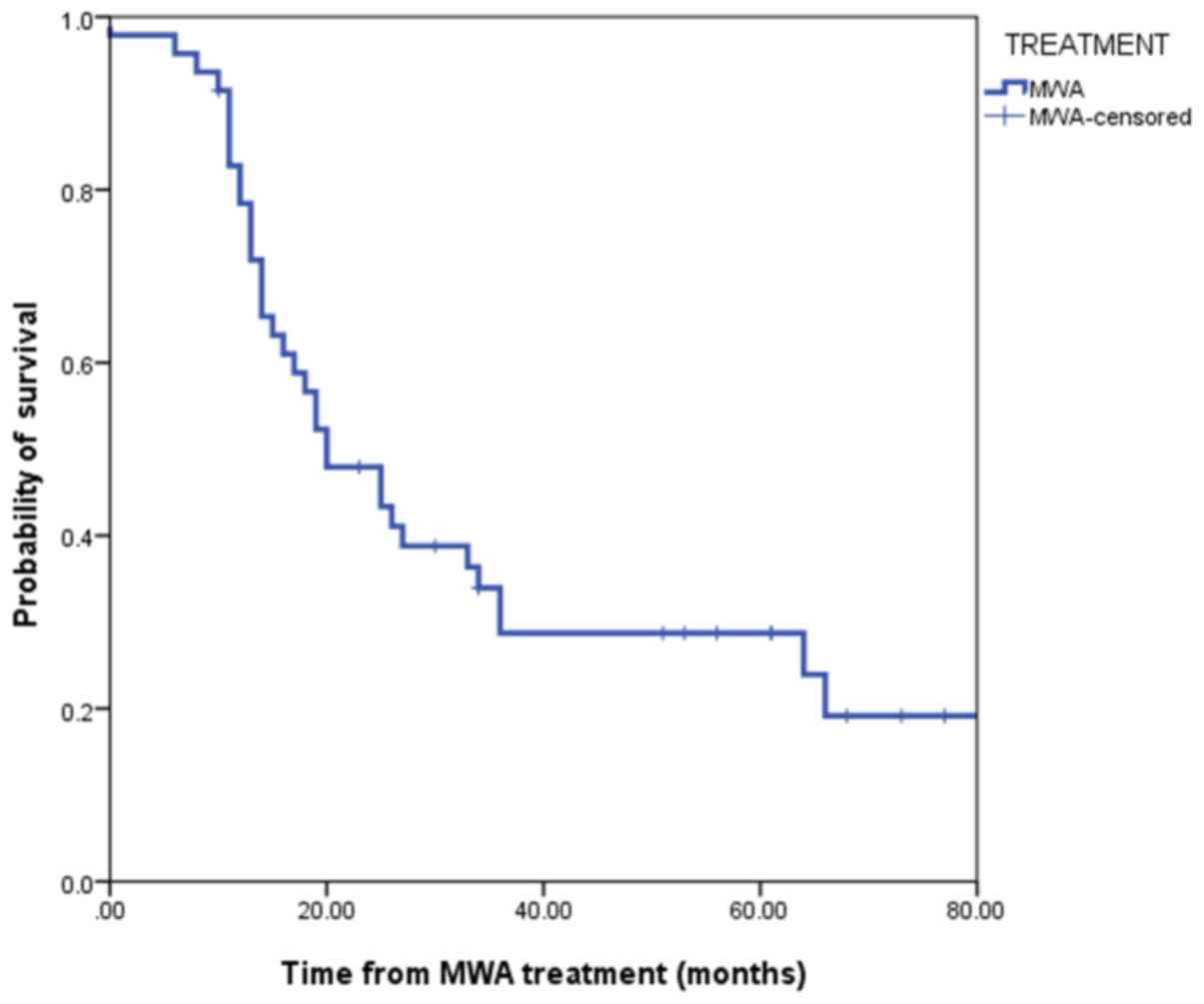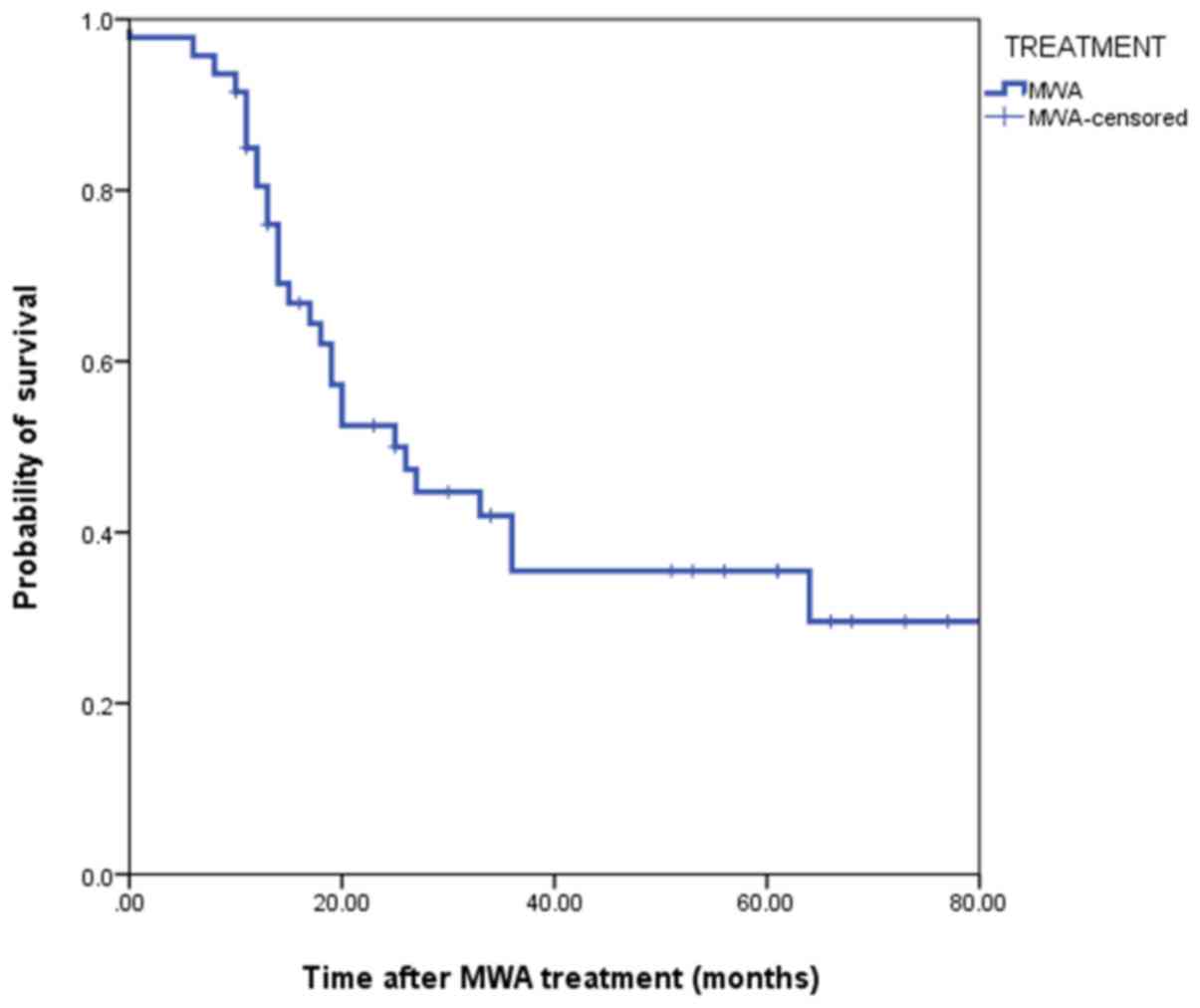|
1
|
Malvezzi M, Carioli G, Bertuccio P,
Boffetta P, Levi F, La Vecchia C and Negri E: European cancer
mortality predictions for the year 2017, with focus on lung cancer.
Ann Oncol. 28:1117–1123. 2017. View Article : Google Scholar : PubMed/NCBI
|
|
2
|
Lewis J, Gillaspie EA, Osmundson EC and
Horn L: Neoadjuvant approaches to locally advanced non-small cell
lung cancer. Front Oncol. 8:52018. View Article : Google Scholar : PubMed/NCBI
|
|
3
|
Ou W, Li N, Wang SY, Li J, Liu QW, Huang
QA and Wang BX: Phase 2 trial of neoadjuvant bevacizumab plus
pemetrexed and carboplatin in patients with unresectable stage III
lung adenocarcinoma (GASTO 1001). Cancer. 122:740–747. 2016.
View Article : Google Scholar : PubMed/NCBI
|
|
4
|
Liu H and Steinke K: High-powered
percutaneous microwave ablation of stage I medically inoperable
non-small cell lung cancer: A preliminary study. J Med Imaging
Radiat Oncol. 57:466–474. 2013. View Article : Google Scholar : PubMed/NCBI
|
|
5
|
Moya-Horno I, Viteri S, Karachaliou N and
Rosell R: Combination of immunotherapy with targeted therapies in
advanced non-small cell lung cancer (NSCLC). Ther Adv Med Oncol.
10:17588340177450122018. View Article : Google Scholar : PubMed/NCBI
|
|
6
|
AmericanCancer Society: Cancer Facts &
Figures. 2017, https://www.cancer.org/cancer/non-small-cell-lung-cancer/detection-diagnosisstaging/survival-rates.html
|
|
7
|
Nour-Eldin NA, Exner S, Al-Subhi M, Naguib
NNN, Kaltenbach B, Roman A and Vogl TJ: Ablation therapy of
non-colorectal cancer lung metastases: Retrospective analysis of
tumour response post-laser-induced interstitial thermotherapy
(LITT), radiofrequency ablation (RFA) and microwave ablation (MWA).
Int J Hyperthermia. 33:820–229. 2017.PubMed/NCBI
|
|
8
|
Zhong L, Sun S, Shi J, Cao F, Han X, Bao X
and You Q: Clinical analysis on 113 patients with lung cancer
treated by percutaneous CT-guided microwave ablation. J Thorac Dis.
9:590–597. 2017. View Article : Google Scholar : PubMed/NCBI
|
|
9
|
Wolf FJ, Grand DJ, Machan JT, Dipetrillo
TA, Mayo-Smith WW and Dupuy DE: Microwave ablation of lung
malignancies: Effectiveness, CT findings, and safety in 50
patients. Radiology. 247:871–879. 2008. View Article : Google Scholar : PubMed/NCBI
|
|
10
|
Vogl TJ, Naguib NN, Gruber-Rouh T, Koitka
K, Lehnert T and Nour-Eldin NE: Microwave ablation therapy:
Clinical utility in treatment of pulmonary metastases. Radiology.
261:643–651. 2011. View Article : Google Scholar : PubMed/NCBI
|
|
11
|
Zheng A, Ye X, Yang X, Huang G and Gai Y:
Local efficacy and survival after microwave ablation of lung
tumors: A retrospective study in 183 patients. J Vasc Interv
Radiol. 27:1806–1814. 2016. View Article : Google Scholar : PubMed/NCBI
|
|
12
|
Pusceddu C, Melis L, Ballicu N, Meloni P,
Sanna V, Porcu A and Fancellu A: Cryoablation of primary breast
cancer in patients with metastatic disease: considerations arising
from a single-centre data analysis. Biomed Res Int.
2017:38390122017. View Article : Google Scholar : PubMed/NCBI
|
|
13
|
Pusceddu C, Melis L, Sotgia B, Fancellu A
and Meloni GB: Computed tomography-guided cryoablation of local
recurrence after primary resection of pancreatic adenocarcinoma.
Clin Pract. 5:7412015. View Article : Google Scholar : PubMed/NCBI
|
|
14
|
Pusceddu C, Sotgia B, Fele RM and Melis L:
Treatment of bone metastases with microwave thermal ablation. J
Vasc Interv Radiol. 24:229–233. 2013. View Article : Google Scholar : PubMed/NCBI
|
|
15
|
Palussière J, Catena V and Buy X:
Percutaneous thermal ablation of lung tumors-Radiofrequency,
microwave and cryotherapy: Where are we going? Diagn Interv
Imaging. 98:619–625. 2017. View Article : Google Scholar : PubMed/NCBI
|
|
16
|
Wang H, Littrup PJ, Duan Y, Zhang Y, Feng
H and Nie Z: Thoracic masses treated with percutaneous cryotherapy:
Initial experience with more than 200 procedures. Radiology.
235:289–298. 2005. View Article : Google Scholar : PubMed/NCBI
|
|
17
|
Hegenscheid K, Behrendt N, Rosenberg C,
Kuehn JP, Ewert R, Hosten N and Puls R: Assessing early vascular
changes and treatment response after laser-induced ther- motherapy
of pulmonary metastases with perfusion CT: Initial experience. AJR
Am J Roentgenol. 194:1116–1123. 2010. View Article : Google Scholar : PubMed/NCBI
|
|
18
|
Belfiore G, Ronza F, Belfiore MP, Serao N,
di Ronza G, Grassi R and Rotondo A: Patients' survival in lung
malignancies treated by microwave ablation: Our experience on 56
patients. Eur J Radiol. 82:177–181. 2013. View Article : Google Scholar : PubMed/NCBI
|
|
19
|
Pusceddu C, Melis L, Fancellu A, Melis M
and Meloni GB: Feasibility and safety of percutaneous
radiofrequency, microwave or cryoablation for unresectable thoracic
malignancies in close proximity to heart and large vessels. Ann
Surg Oncol. 20:S1072013.
|
|
20
|
Zheng A, Wang X, Yang X, Wang W, Huang G,
Gai Y and Ye X: Major complications after lung microwave ablation:
A single-center experience on 204 sessions. Ann Thorac Surg.
98:243–248. 2014. View Article : Google Scholar : PubMed/NCBI
|
|
21
|
Pusceddu C, Melis L, Ballicu N, Sotgia B,
Melis M, Sanna V, Meloni GB, Porcu A and Fancellu A: Percutaneous
microwave ablation under CT guidance for hepatocellular carcinoma:
A single institutional experience. J Gastrointest Cancer.
49:295–301. 2018. View Article : Google Scholar : PubMed/NCBI
|
|
22
|
Carrafiello G, Mangini M, Fontana F,
Ierardi AM, De Marchi G, Rotolo N, Chini C, Cuffari S and Fugazzola
C: Microwave ablation of lung tumors: Single-centre preliminary
experience. Radiol Med. 119:75–82. 2014. View Article : Google Scholar : PubMed/NCBI
|
|
23
|
Yang X, Ye X, Zheng A, Huang G, Ni X, Wang
J, Han X, Li W and Wei Z: Percutaneous microwave ablation of stage
I medically inoperable non-small cell lung cancer: Clinical
evaluation of 47 cases. J Surg Oncol. 110:758–763. 2014. View Article : Google Scholar : PubMed/NCBI
|
|
24
|
Macchi M, Belfiore MP, Floridi C, Serra N,
Belfiore G, Carmignani L, Grasso RF, Mazza E, Pusceddu C, Brunese L
and Carrafiello G: Radiofrequency versusmicrowave ablation for
treatment of the lung tumors: LUMIRA (lung microwave
radiofrequency) randomized trial. Med Oncol. 34:962014. View Article : Google Scholar
|
|
25
|
Lackey A and Donington JS: Surgical
management of lung cancer. Semin Intervent Radiol. 30:133–140.
2013. View Article : Google Scholar : PubMed/NCBI
|
|
26
|
Narsule CK, Sridhar P, Nair D, Gupta A,
Oommen RG, Ebright MI, Litle VR and Fernando HC: Percutaneous
thermal ablation for stage IA non-small cell lung cancer: Long-term
follow-up. J Thorac Dis. 9:4039–4045. 2017. View Article : Google Scholar : PubMed/NCBI
|
|
27
|
Yang X, Ye X, Huang G, Han X, Wang J, Li
W, Wei Z and Meng M: Repeated percutaneous microwave ablation for
local recurrence of inoperable Stage I nonsmall cell lung cancer. J
Cancer Res Ther. 13:683–688. 2017. View Article : Google Scholar : PubMed/NCBI
|
|
28
|
Maxwell AWP, Healey TT and Dupuy DE:
Microwave ablation of lung tumors near the heart: A retrospective
review of short-term procedural safety in ten patients. Cardiovasc
Intervent Radiol. 40:1401–1407. 2017. View Article : Google Scholar : PubMed/NCBI
|
|
29
|
De Tollenaere C, Lievens Y, Vandecasteele
K, Vermaelen K and Surmont V: Unresectable stage III non-small-cell
lung cancer: Have we made any progress? World J Respirol.
5:140–151. 2015. View Article : Google Scholar
|
|
30
|
Stinchcombe TE and Bogart JA: Novel
approaches of chemoradiotherapy in unresectable stage IIIA and
stage IIIB non-small cell lung cancer. Oncologist. 17:682–693.
2012. View Article : Google Scholar : PubMed/NCBI
|
|
31
|
Caglar HB, Baldini EH, Othus M, Rabin MS,
Bueno R, Sugarbaker DJ, Mentzer SJ, Jänne PA, Johnson BE and Allen
AM: Outcomes of patients with stage III nonsmall cell lung cancer
treated with chemotherapy and radiation with and without surgery.
Cancer. 115:4156–4166. 2009. View Article : Google Scholar : PubMed/NCBI
|
|
32
|
Wang H, Zhang J, Shi F, Zhang C, Jiao Q
and Zhu H: Better cancer specific survival in young small cell lung
cancer patients especially with AJCC stage III. Oncotarget.
8:34923–34934. 2017.PubMed/NCBI
|
|
33
|
Lu Q, Cao W, Huang L, Wan Y, Liu T, Cheng
Q, Han Y and Li X: CT-guided percutaneous microwave ablation of
pulmonary malignancies: Results in 69 cases. World J Surg Oncol.
10:802012. View Article : Google Scholar : PubMed/NCBI
|
|
34
|
NCCN guidelines for Non-Small Cell Lung
Cancer (Ver. 4.2018-April 2018). https://www.nccn.org/store/login/login.aspxReturnURL=https://www.nccn.org/professionals/physician_gls/pdf/nscl.pdf
|
|
35
|
Postmus PE, Kerr KM, Oudkerk M, Senan S,
Waller DA, Vansteenkiste J, Escriu C and Peters S; ESMO Guidelines
Committee, : Early and locally advanced non-small- cell lung cancer
(NSCLC): ESMO Clinical Practice Guidelines for diagnosis, treatment
and follow-up. Ann Oncol. 28 (Suppl 4):iv1–iv21. 2017. View Article : Google Scholar : PubMed/NCBI
|
|
36
|
Howington JA, Blum MG, Chang AC, Balekian
AA and Murthy SC: Treatment of stage I and II non-small cell lung
cancer: Diagnosis and management of lung cancer, 3rd ed: American
College of Chest Physicians evidence-based clinical practice
guidelines. Chest 143 (5 Suppl). e278S–e313S. 2013. View Article : Google Scholar
|
|
37
|
Wei Z, Ye X, Yang X, Zheng A, Huang G, Li
W, Wang J, Han X, Meng M and Ni Y: Microwave ablation combined with
EGFR-TKIs versus only EGFR-TKIs in advanced NSCLC patients with
EGFR-sensitive mutations. Oncotarget. 8:56714–56725. 2017.
View Article : Google Scholar : PubMed/NCBI
|
|
38
|
Ni Y, Bi J, Ye X, Fan W, Yu G, Yang X,
Huang G, Li W, Wang J, Han X, et al: Local microwave ablation with
continued EGFR tyrosine kinase inhibitor as a treatment strategy in
advanced non-small cell lung cancers that developed extra-central
nervous system oligoprogressive disease during EGFR tyrosine kinase
inhibitor treatment: A pilot study. Medicine (Baltimore).
95:e39982016. View Article : Google Scholar : PubMed/NCBI
|



